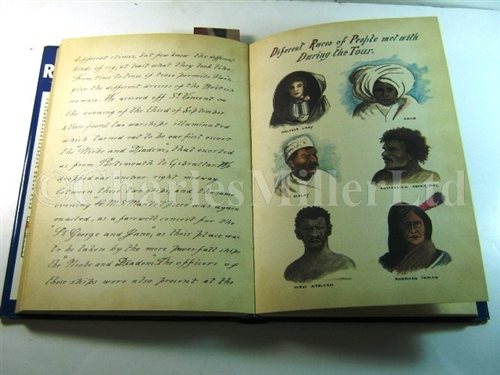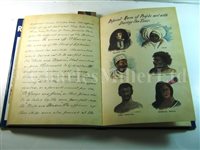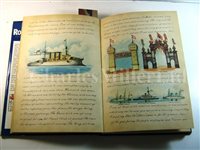29th Oct, 2014 12:00
Maritime and Scientific Models, Instruments & Art (Wizard)
48
[M] H.M. ROYAL YACHT OPHIR (1901)<br/>an impressive...
H.M. ROYAL YACHT OPHIR (1901)
an impressive ship's badge, removed from one of the two 32-foot steam cutters carried aboard Ophir during her royal tenure, the oval copper plate depicting the yacht's distinctive device of a Tudor rose within a royal garter engraved Honi Soit Qui Mal Y Pense and laid upon the stock of a crowned anchor, with rope-twist border -- 12½ x 9½in. (32 x 24cm.), mounted on a wooden oval for display, an interesting relic of the rare charter of a commercial vessel for royal duty; sold with a printed copy of the illustrated mss. journal of Petty Officer Harry Price, RN, entitled The Royal Tour, 1901, or the Cruise of H.M.S. Ophir, publ. by Webb & Bower, Exeter, 1980
Ophir was a highly distinctive twin-screw steamer ordered for the Orient Line's prestigious Australian service in 1891. Built by Robert Napier & Sons at Glasgow, she was registered at 6,814 tons gross (2,920 net) and measured 465 feet in length with a 53½ foot beam. Powered by two of her builder's own triple-expansion engines she could make 18 knots at full speed and, whilst she had passenger accommodation in three classes, her first class public rooms were particularly lavish. In fact, so luxurious were her appointments that she proved a logical choice when the government found it necessary to charter a suitable liner to convey the Duke and Duchess of York (later King George V and Queen Mary) on their overseas tour in 1901. After minor modifications, including the positioning of two 32-foot steam cutters over the poop, and thereafter repainted in her new white livery, Ophir left Portsmouth on 16th March 1901 for the first-ever Royal Tour in the modern sense. Every continent in the Empire was visited except India, and by the end of the seven-month voyage, she had steamed 45,000 miles. Returning to commercial sailings the following year, her royal connection made her even more popular with the travelling public although her running costs were so high that she was frequently laid up during the low season. Serving as an armed merchant cruiser during the Great War, she was paid off for the last time in 1919 and broken up in 1922.
an impressive ship's badge, removed from one of the two 32-foot steam cutters carried aboard Ophir during her royal tenure, the oval copper plate depicting the yacht's distinctive device of a Tudor rose within a royal garter engraved Honi Soit Qui Mal Y Pense and laid upon the stock of a crowned anchor, with rope-twist border -- 12½ x 9½in. (32 x 24cm.), mounted on a wooden oval for display, an interesting relic of the rare charter of a commercial vessel for royal duty; sold with a printed copy of the illustrated mss. journal of Petty Officer Harry Price, RN, entitled The Royal Tour, 1901, or the Cruise of H.M.S. Ophir, publ. by Webb & Bower, Exeter, 1980
Ophir was a highly distinctive twin-screw steamer ordered for the Orient Line's prestigious Australian service in 1891. Built by Robert Napier & Sons at Glasgow, she was registered at 6,814 tons gross (2,920 net) and measured 465 feet in length with a 53½ foot beam. Powered by two of her builder's own triple-expansion engines she could make 18 knots at full speed and, whilst she had passenger accommodation in three classes, her first class public rooms were particularly lavish. In fact, so luxurious were her appointments that she proved a logical choice when the government found it necessary to charter a suitable liner to convey the Duke and Duchess of York (later King George V and Queen Mary) on their overseas tour in 1901. After minor modifications, including the positioning of two 32-foot steam cutters over the poop, and thereafter repainted in her new white livery, Ophir left Portsmouth on 16th March 1901 for the first-ever Royal Tour in the modern sense. Every continent in the Empire was visited except India, and by the end of the seven-month voyage, she had steamed 45,000 miles. Returning to commercial sailings the following year, her royal connection made her even more popular with the travelling public although her running costs were so high that she was frequently laid up during the low season. Serving as an armed merchant cruiser during the Great War, she was paid off for the last time in 1919 and broken up in 1922.
Sold for £397
Estimated at £300 - £400
(inc. buyer's premium of 24%)
H.M. ROYAL YACHT OPHIR (1901)
an impressive ship's badge, removed from one of the two 32-foot steam cutters carried aboard Ophir during her royal tenure, the oval copper plate depicting the yacht's distinctive device of a Tudor rose within a royal garter engraved Honi Soit Qui Mal Y Pense and laid upon the stock of a crowned anchor, with rope-twist border -- 12½ x 9½in. (32 x 24cm.), mounted on a wooden oval for display, an interesting relic of the rare charter of a commercial vessel for royal duty; sold with a printed copy of the illustrated mss. journal of Petty Officer Harry Price, RN, entitled The Royal Tour, 1901, or the Cruise of H.M.S. Ophir, publ. by Webb & Bower, Exeter, 1980
Ophir was a highly distinctive twin-screw steamer ordered for the Orient Line's prestigious Australian service in 1891. Built by Robert Napier & Sons at Glasgow, she was registered at 6,814 tons gross (2,920 net) and measured 465 feet in length with a 53½ foot beam. Powered by two of her builder's own triple-expansion engines she could make 18 knots at full speed and, whilst she had passenger accommodation in three classes, her first class public rooms were particularly lavish. In fact, so luxurious were her appointments that she proved a logical choice when the government found it necessary to charter a suitable liner to convey the Duke and Duchess of York (later King George V and Queen Mary) on their overseas tour in 1901. After minor modifications, including the positioning of two 32-foot steam cutters over the poop, and thereafter repainted in her new white livery, Ophir left Portsmouth on 16th March 1901 for the first-ever Royal Tour in the modern sense. Every continent in the Empire was visited except India, and by the end of the seven-month voyage, she had steamed 45,000 miles. Returning to commercial sailings the following year, her royal connection made her even more popular with the travelling public although her running costs were so high that she was frequently laid up during the low season. Serving as an armed merchant cruiser during the Great War, she was paid off for the last time in 1919 and broken up in 1922.
an impressive ship's badge, removed from one of the two 32-foot steam cutters carried aboard Ophir during her royal tenure, the oval copper plate depicting the yacht's distinctive device of a Tudor rose within a royal garter engraved Honi Soit Qui Mal Y Pense and laid upon the stock of a crowned anchor, with rope-twist border -- 12½ x 9½in. (32 x 24cm.), mounted on a wooden oval for display, an interesting relic of the rare charter of a commercial vessel for royal duty; sold with a printed copy of the illustrated mss. journal of Petty Officer Harry Price, RN, entitled The Royal Tour, 1901, or the Cruise of H.M.S. Ophir, publ. by Webb & Bower, Exeter, 1980
Ophir was a highly distinctive twin-screw steamer ordered for the Orient Line's prestigious Australian service in 1891. Built by Robert Napier & Sons at Glasgow, she was registered at 6,814 tons gross (2,920 net) and measured 465 feet in length with a 53½ foot beam. Powered by two of her builder's own triple-expansion engines she could make 18 knots at full speed and, whilst she had passenger accommodation in three classes, her first class public rooms were particularly lavish. In fact, so luxurious were her appointments that she proved a logical choice when the government found it necessary to charter a suitable liner to convey the Duke and Duchess of York (later King George V and Queen Mary) on their overseas tour in 1901. After minor modifications, including the positioning of two 32-foot steam cutters over the poop, and thereafter repainted in her new white livery, Ophir left Portsmouth on 16th March 1901 for the first-ever Royal Tour in the modern sense. Every continent in the Empire was visited except India, and by the end of the seven-month voyage, she had steamed 45,000 miles. Returning to commercial sailings the following year, her royal connection made her even more popular with the travelling public although her running costs were so high that she was frequently laid up during the low season. Serving as an armed merchant cruiser during the Great War, she was paid off for the last time in 1919 and broken up in 1922.
Auction: Maritime and Scientific Models, Instruments & Art (Wizard), 29th Oct, 2014



